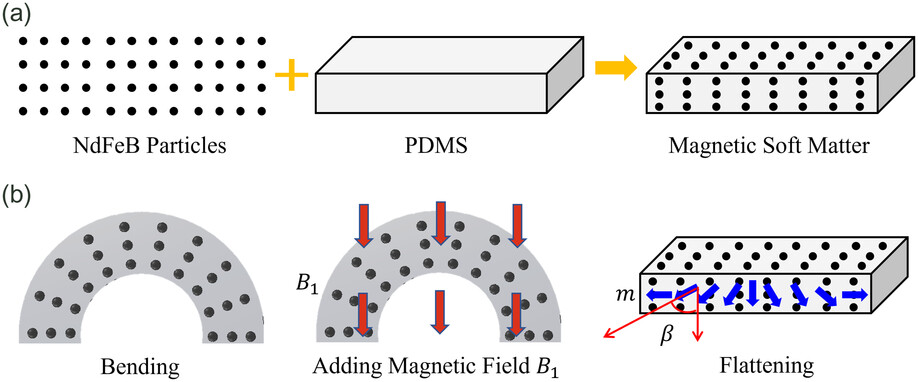| May 30, 2024 | |
Squishy magnetic microjoints bend the rules of microrobotics |
|
| (Nanowerk Spotlight) Robotic micromanipulation, which involves robots handling tiny objects, has long been limited by the challenges of integrating rotational joints at microscopic scales. The ability to precisely rotate and orient objects is crucial for complex micromanipulation tasks like cell rotation and industrial microassembly. | |
| However, space constraints and manufacturing difficulties have made it infeasible to include traditional rotational components like motors in micromanipulation systems. As a result, most robotic micromanipulators rely on simple three-axis translational movement, potentially restricting their dexterity and increasing the risk of damaging delicate objects. | |
| Over the years, researchers have explored various microactuation methods to enable rotational movement, including using magnetic microspheres, pH changes, thermal effects, electrical signals, and optical techniques. However, these approaches tend to involve complicated fabrication processes and are difficult to model and control, greatly limiting their practical application. | |
| More recently, soft robotics has emerged as a promising avenue for enabling flexibility at small scales. Soft robots can be actuated through methods like tendon-driven systems, shape memory alloys, and pneumatic pressure. But again, challenges arise in terms of relying on bulky external components, slow response times, and complex deformation mechanics. | |
| Now, an innovative new approach detailed in the Advanced Intelligent Systems journal ("Design of Soft Microjoint to Improve Robotic Cell Micromanipulation Flexibility") may finally provide a viable solution. A research team has developed a soft, magnetically-controlled rotating microjoint that can flex and bend to grip and manipulate objects with unprecedented dexterity at the microscale. | |
| The joint is composed of a composite material made by mixing soft polydimethylsiloxane (PDMS) polymer with magnetic neodymium-iron-boron (NdFeB) microparticles. By applying a magnetic field, the orientation of the magnetic particles can be controlled, causing the soft joint to bend and rotate to specified angles. | |
 |
|
| Fabrication of programmable soft material rotating joints. a) The fabrication process of programmable materials. The soft material is synthesized by mixing NdFeB particles with PDMS. b) Magnetization process of magnetic materials. The fabricated programmable soft material is bent and then magnetized in a strong magnetic field. (Image: Reprinted from DOI:10.1002/aisy.202400068, CC BY) | |
| The preparation involves mixing the silicone elastomer base and curing agent in a 10:1 ratio, combining this with NdFeB particles in a 1:3 mass ratio, and curing the mixture at specified temperatures to achieve the desired programmable soft material. This material is then cut into microjoints and magnetized in a strong magnetic field. | |
| What's particularly remarkable is the rotational performance the team achieved with their microjoints. The joints demonstrated a maximum bending angle of over 22.16 degrees and a response time of just 16 milliseconds. This means the joint can very rapidly flex between different orientations, opening up new possibilities for fast and agile micromanipulation. The response time is also independent of the input current and rotation angle, enabling consistent dynamic performance. | |
| To precisely control the bending, the researchers developed a model that relates the rotational deflection of the joint to the applied magnetic field strength. This led them to design a closed-loop control system using a sliding mode controller based on radial basis function neural networks. The advanced controller adapts to changes in the microjoint's mechanical properties and can robustly handle disturbances like time-varying loads when the joint contacts an object. Experiments showed this controller could achieve high angle control accuracy, outperforming conventional PID and sliding mode control approaches. | |
| As an initial demonstration of the microjoint's potential, the team integrated it with a soft suction pipette to create a highly dexterous micromanipulation tool. They used this set-up to successfully grasp and orient zebrafish embryos, a common model organism in biological research. The microjoint enabled the embryos to be picked up and rotated to desired poses with a high 97% success rate and an average orientation error of just 1.36 degrees. This type of flexible, precise control is extremely difficult to achieve with purely translational micromanipulators. | |
| Looking ahead, the researchers believe their microjoints could enable a new level of sophistication for robotic micromanipulation systems. By chaining together multiple microjoints in different orientations, it should be feasible to build complete multi-degree-of-freedom micromanipulator arms capable of complex 3D trajectories and object handling. | |
| With further miniaturization, the joints could be a key building block for soft microrobotics, enabling tiny machines that can nimbly navigate confined spaces and interact with their environment. Potential applications span from biomedical procedures to microassembly of electronics and MEMS devices. | |
| At the same time, challenges remain in reducing the cost and bulk of the required control hardware, like the electromagnetic coils and power systems. There are also open questions around the scalability of the microjoint fabrication process. Nonetheless, this work marks a major leap forward in the long-running quest to build flexible, versatile microrobotic systems. By harnessing the power of soft materials and magnetic control, these squishy, dexterous joints may bend the future of micromanipulation in exciting new directions. | |
 By
Michael
Berger
– Michael is author of three books by the Royal Society of Chemistry:
Nano-Society: Pushing the Boundaries of Technology,
Nanotechnology: The Future is Tiny, and
Nanoengineering: The Skills and Tools Making Technology Invisible
Copyright ©
Nanowerk LLC
By
Michael
Berger
– Michael is author of three books by the Royal Society of Chemistry:
Nano-Society: Pushing the Boundaries of Technology,
Nanotechnology: The Future is Tiny, and
Nanoengineering: The Skills and Tools Making Technology Invisible
Copyright ©
Nanowerk LLC
|
|
|
Become a Spotlight guest author! Join our large and growing group of guest contributors. Have you just published a scientific paper or have other exciting developments to share with the nanotechnology community? Here is how to publish on nanowerk.com. |
|
